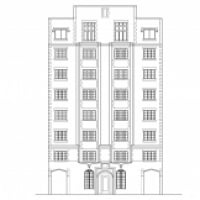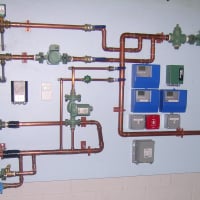Historical Heating System Changes Over Time
Comments
-
I think gravity hot air systems were installed in the late 1800's as well and may have been just a little earlier than one pipe steam but were also installed during the same timeframe as steam.0
-
-
In my Midwest town in SE Iowa, I see the following.... from what’s left.
Gravity hot air from 1870-1890 and lower value homes to 1915 or when the home was electrified about that time.
1 pipe steam 1880-1915
2 pipe steam 1910-1930
Hot water high mass radiators 1925-1935
Hot water fin tube 1950-1970
Radiant floor heat 2000-today
1935-1950, minimal construction in this area, as in most. 1970-2000, modern construction of medium sized homes, all forced air.
Radiant floor heat has started ot gain popularity, especially with low cost construction in rural areas or slab construction stick frame simple rectangular construction. Often Amish built, plans from a lumber yard.
The evolution here was coal fired up until 1920, then oil for new construction and oil conversions for older ones through 1960. Gas conversions from 1960-1980, then boilers were replaced or abandoned as the last of the old timers retired and the knowledge was lost and customer demand for radiant heat died off.
Overall gravity hot air ruled. Keep in mind that it’s only a 6 month heating season, not 6-7 like the northwest or further north. But you probably see larger windows and a higher window count because of the hot humid summers with most attics have operable windows or venting features.0 -
As @Fred and @mikeg2015 have implied, it varies so much with the geographic area -- but also with the quality of the home (industrial/commercial is another story altogether). There is also a tremendous overlap in when different systems were installed, so it is at best risky to even think along the lines of "this is one pipe steam, so it must have been installed between x and y". In New England -- at least in the more rural areas -- gravity hot air in its most primitive form (a nice big stove on the lowest level and floor grates to higher floors) goes way back -- early to mid 1800s at least -- and gradually morphed in the better houses to various ducted systems (still gravity) in the later 1800s. One doesn't see forced air until the 1940s, really, and it started in the lower quality homes. Steam came in apparently in the late 1800s -- first one pipe, but changing very quickly to two pipe as soon as reliable traps became available. It was still being installed in better quality homes up to the 1940s, particularly vapour systems. I at least haven't encountered much in the way of gravity hot water so I wouldn't care to say about dates. Forced hot water, though, doesn't seem to have shown up until the 1930s or 1940s.
Or so it seems, based on a tiny sample of hardly representative observations...Br. Jamie, osb
Building superintendent/caretaker, 7200 sq. ft. historic house museum with dependencies in New England0 -
I didnt’ even mention pre-1860, which would be mostly fireplaces and wood stoves. Coal wasn’t a primary source of energy until the expansion of the railroad to all areas.0
-
In the Baltimore area, one-pipe steam predominated in smaller homes up to the mid 1930s or so, though there was a lot of gravity hot-water as well. After that, forced hot-water using oil-fired boilers having tankless coils. Most of the larger homes were Vapor or gravity hot-water.
In many cases, radiator systems were installed in existing houses that originally had floor furnasties or ducted gravity hot air. This was (and still is IMHO) an upgrade since no air-based system can offer the comfort or efficiency of steam or hot-water.
Forced-air started taking over after World War II, because it was cheap and builders didn't care about comfort or efficiency.
@cubicacres , how's the building I looked at doing?All Steamed Up, Inc.
Towson, MD, USA
Steam, Vapor & Hot-Water Heating Specialists
Oil & Gas Burner Service
Consulting0 -
Thanks for the history lesson! Is it fair to say as technolgies changed over time, people used different systems for increased efficiency/lower operating costs, and increased control/comfort? If you could buy a building with any type of heating system today, which would you prefer most? After getting some experience with our single-pipe steam building, we might prefer to stick with another single-pipe system on another building, but hot water seems like it would be easier to service if we don't do it ourselves?
Steamhead-our building is doing well. Using the steamaster tablets helps us not to worry about higher city water use (10-20 gallons/month new water) corroding the boiler as much, but we could always be doing more Tenants tell us it's more comfortable in the colder winter months, with more fluctuations in the fall/spring, but still better than the older larger boiler. 76F on the 2nd floor compared to 86 with the old boiler. We also used 3 small valves just before the radiator air vents to shut off the radiators up there with just 2 radiators remaining out of 5 for the tenant's optimized comfort. They tell us it's much better now. 0
Tenants tell us it's more comfortable in the colder winter months, with more fluctuations in the fall/spring, but still better than the older larger boiler. 76F on the 2nd floor compared to 86 with the old boiler. We also used 3 small valves just before the radiator air vents to shut off the radiators up there with just 2 radiators remaining out of 5 for the tenant's optimized comfort. They tell us it's much better now. 0 -
I’ll add that I think a lot of knowledge was lost from 1930-1948. Due to the depression, new construction nearly stopped and then steam fitters and all skilled labor went to war, many I suspect were responsible to keeping ships and aircraft running.Steamhead said:
Forced-air started taking over after World War II, because it was cheap and builders didn't care about comfort or efficiency.
Then I agree, that demand for premium heating systems ended and fin tube promised the comfort of those old radiators at a fraction of the cost.
Soon we had Air Conditoning, and it became a very hard sell to install all that piping AND all the ductwork for AC. IF you install AC/ might as well plop in a furnace.
TO further compound problems, electricity was dirt cheap and all electric homes because a fad. from the late 50’s to early 70’s I’d guess that over 50% of the local homes built were all electric. We’ve made a good business of installing heat pump and even natural gas installations. SOme small 1200-1500sqft ranches cost as much to heat as my 3300sqft brick Victorian. It’s insane. Iowa’s high electric rates due to subsidizing wind energy to power tree hugging liberals in Des Moines in their cookie cutter McMansions with undersized flex duct and oversized AC systems, isn’t helping. (Sorry crossed a political line there...haha)0 -
The availability of electricity would have been a determining factor for many choices of heating.
My little village got it's first power plant in about 1920. It was shut down overnight from 10 PM to 6 AM. (Why would you need power after 10 PM in 1920?). But eventually there was a demand for 24/7 power. That was the case in many small towns then.
In the country the REA, (Government program of Rural Electrification Administration) came down my highway in the early 1950's. Until then country people may have had a 32 volt Wincharger system or just went without. The oldtimers told me that the REA had a hard sell to get power lines to some farms....why do we need it??
So in the country heating stoves burned wood, some coal, corn cobs, oil and sometimes even cow chips. Eventually LPG showed up here in the 50's also. NG in 1967 for the towns.
So with no electricity there were no pumps, fans or modern safety controls.
There were a handful of gravity manual stoked air and water systems. Just a couple of steamers.0 -
Judging from the wall ac units I see in my area and in SE Wisconsin (even fairly new buildings) I would guess that baseboard, either electric or hot water is still fairly common.
In Chicago, most average quality apartment buildings (2, 3 & 6 flats along with courtyard buildings) were one-pipe through to the depression. More variety in higher end and highrise buildings. A lot of two flats had hot air since it was easy enough to run the ductwork for the air and install two furnaces.
Lots more variety in bungalows, but by about 1960 the demand for AC switched developer built housing to GFA, though there was still a lot of hot water baseboard installed with wall units.0 -
I'd still repipe that one overloaded main ;-)cubicacres said:Steamhead-our building is doing well. Using the steamaster tablets helps us not to worry about higher city water use (10-20 gallons/month new water) corroding the boiler as much, but we could always be doing more
 Tenants tell us it's more comfortable in the colder winter months, with more fluctuations in the fall/spring, but still better than the older larger boiler. 76F on the 2nd floor compared to 86 with the old boiler. We also used 3 small valves just before the radiator air vents to shut off the radiators up there with just 2 radiators remaining out of 5 for the tenant's optimized comfort. They tell us it's much better now.
Tenants tell us it's more comfortable in the colder winter months, with more fluctuations in the fall/spring, but still better than the older larger boiler. 76F on the 2nd floor compared to 86 with the old boiler. We also used 3 small valves just before the radiator air vents to shut off the radiators up there with just 2 radiators remaining out of 5 for the tenant's optimized comfort. They tell us it's much better now.
Steam!cubicacres said:If you could buy a building with any type of heating system today, which would you prefer most?
All Steamed Up, Inc.
Towson, MD, USA
Steam, Vapor & Hot-Water Heating Specialists
Oil & Gas Burner Service
Consulting0 -
As a radiant heating guy I just feel that I had to throw in my two cents.
More than two thousand years ago the ancient Roman empire discovered luxurious and comfortable radiant heating. They had warm floors and walls installed into all of the bath houses. The wealthiest of the Romans constantly tried to outdo each other with fancier and bigger privet bath houses. The common man enjoyed relaxing in the slow warmth of the radiant waves at the public baths. Every city had a few public bath house’s and they all had radiant heat. Below is a picture of a hypocaust. A hypocaust was the Roman heating system that delivered radiant heat.
John Ruhnke
http://www.comfortableheat.com/green-heating/radiant/ancient-roman-heating/
I am the walking Deadman
Hydronics Designer
Hydronics is the most comfortable and energy efficient HVAC system.0
Categories
- All Categories
- 87.3K THE MAIN WALL
- 3.2K A-C, Heat Pumps & Refrigeration
- 61 Biomass
- 429 Carbon Monoxide Awareness
- 120 Chimneys & Flues
- 2.1K Domestic Hot Water
- 5.8K Gas Heating
- 115 Geothermal
- 166 Indoor-Air Quality
- 3.7K Oil Heating
- 77 Pipe Deterioration
- 1K Plumbing
- 6.5K Radiant Heating
- 395 Solar
- 15.7K Strictly Steam
- 3.4K Thermostats and Controls
- 56 Water Quality
- 51 Industry Classes
- 50 Job Opportunities
- 18 Recall Announcements



